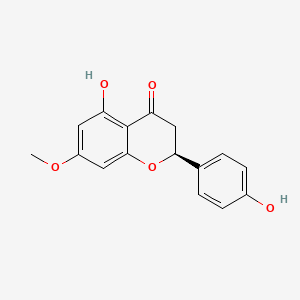| MeSH term | MeSH ID | Detail |
|---|---|---|
| Acne Vulgaris | D000152 | 35 associated lipids |
Sakuranetin
Sakuranetin is a lipid of Polyketides (PK) class. Sakuranetin is associated with abnormalities such as and Neurodegenerative Disorders. The involved functions are known as inhibitors, Drug Interactions, aldehyde reductase activity, Antiinflammatory Effect and antagonists. Sakuranetin often locates in Vacuole and Cell surface. The associated genes with Sakuranetin are PTPN1 gene.
Cross Reference
Introduction
To understand associated biological information of Sakuranetin, we collected biological information of abnormalities, associated pathways, cellular/molecular locations, biological functions, related genes/proteins, lipids and common seen animal/experimental models with organized paragraphs from literatures.
What diseases are associated with Sakuranetin?
Sakuranetin is suspected in Neurodegenerative Disorders and other diseases in descending order of the highest number of associated sentences.
Related references are mostly published in these journals:
| Disease | Cross reference | Weighted score | Related literature |
|---|
Possible diseases from mapped MeSH terms on references
We collected disease MeSH terms mapped to the references associated with Sakuranetin
PubChem Associated disorders and diseases
What pathways are associated with Sakuranetin
There are no associated biomedical information in the current reference collection.
PubChem Biomolecular Interactions and Pathways
Link to PubChem Biomolecular Interactions and PathwaysWhat cellular locations are associated with Sakuranetin?
Visualization in cellular structure
Associated locations are in red color. Not associated locations are in black.
Related references are published most in these journals:
| Location | Cross reference | Weighted score | Related literatures |
|---|
What functions are associated with Sakuranetin?
Related references are published most in these journals:
| Function | Cross reference | Weighted score | Related literatures |
|---|
What lipids are associated with Sakuranetin?
There are no associated biomedical information in the current reference collection.
What genes are associated with Sakuranetin?
Related references are published most in these journals:
| Gene | Cross reference | Weighted score | Related literatures |
|---|
What common seen animal models are associated with Sakuranetin?
There are no associated biomedical information in the current reference collection.
NCBI Entrez Crosslinks
All references with Sakuranetin
Download all related citations| Authors | Title | Published | Journal | PubMed Link |
|---|---|---|---|---|
| Alam P et al. | Inter-species comparative antioxidant assay and HPTLC analysis of sakuranetin in the chloroform and ethanol extracts of aerial parts of Rhus retinorrhoea and Rhus tripartita. | 2017 | Pharm Biol | pmid:28345446 |
| Medić-Sarić M et al. | From functional food to medicinal product: systematic approach in analysis of polyphenolics from propolis and wine. | 2009 | Nutr J | pmid:19624827 |
| Katsumata S et al. | Xylosylated Detoxification of the Rice Flavonoid Phytoalexin Sakuranetin by the Rice Sheath Blight Fungus Rhizoctonia solani. | 2018 | Molecules | pmid:29382171 |
| Jeong H et al. | Hepatic Metabolism of Sakuranetin and Its Modulating Effects on Cytochrome P450s and UDP-Glucuronosyltransferases. | 2018 | Molecules | pmid:29949932 |
| Hasegawa M et al. | Analysis on blast fungus-responsive characters of a flavonoid phytoalexin sakuranetin; accumulation in infected rice leaves, antifungal activity and detoxification by fungus. | 2014 | Molecules | pmid:25093982 |
| dos S Grecco S et al. | Structural crystalline characterization of sakuranetin--an antimicrobial flavanone from twigs of Baccharis retusa (Asteraceae). | 2014 | Molecules | pmid:24914898 |
| Hernández V et al. | Effects of naturally occurring dihydroflavonols from Inula viscosa on inflammation and enzymes involved in the arachidonic acid metabolism. | 2007 | Life Sci. | pmid:17658557 |
| Jung YH et al. | Differential expression of defense/stress-related marker proteins in leaves of a unique rice blast lesion mimic mutant (blm). | 2006 | J. Proteome Res. | pmid:17022630 |
| Kobayashi S et al. | Transport mechanisms of flavanone aglycones across Caco-2 cell monolayers and artificial PAMPA membranes. | 2012 | J. Pharm. Pharmacol. | pmid:22150672 |
| Rivero-Cruz I et al. | Antimycobacterial agents from selected Mexican medicinal plants. | 2005 | J. Pharm. Pharmacol. | pmid:16105233 |
